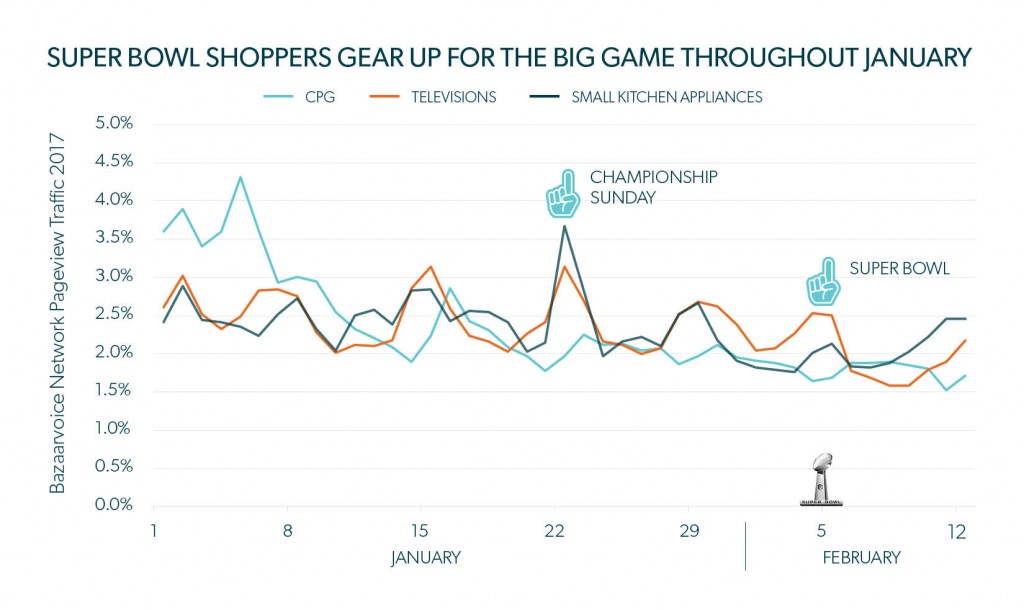January 31, 2018
If you’re not running a commercial spot during the super bowl, it’s okay. Most of us aren’t. While a 30-second commercial spot has the ability to reach 112 million viewers, that commercial can cost you more than 5 million dollars.
That’s a high price to pay for 30 seconds of one-way communication to a viewer that may not be in-market for your product. With the high price point and no promise of engagement, many marketers look outside the traditional commercial space during the Super Bowl.
As more watchers engage with social media during the game and online ad opportunities increase, there are many ways for brands of all kinds to capture the Super Bowl audience. In this game, a viewer is a receiver, a marketer is a quarterback, and engagement is a touchdown.
The digital playing field
For any brand considering marketing on or around the Super Bowl, it’s critical to understand as much as you can about your audience. What does the audience look like? How are consumers engaging with brands and products before, during, and after the game?
In the weeks leading up to the Super Bowl, fans are watching the playoff games and prepping for their Super Bowl parties. Our own shopper data shows that online shopping activity for game day essentials like televisions, small kitchen appliances, paper and plastic goods, and fan gear increases as Super Bowl Sunday nears. If it makes sense for your brand, this preparation period is a great time to reach in-market shoppers — leave the noise and competition of the big day to everyone else.

On game day itself, all kinds of data has shown that Super Bowl watchers are multitasking across different devices around game time. Tens of millions of fans plan to both watch the game live on TV while also checking stats on sports apps, playing games, shopping, and engaging with social media on their mobile device. Mobile is a clear opportunity for brands, with 82% of viewers using a smartphone during the game.
What are those viewers doing on their phones? Engaging with social media. An estimated 78% of viewers will engage with social media during the game. Last year, there were 240 million Facebook interactions, 27.6 million tweets, and 150 million Instagram interactions related to the Super Bowl, almost all of which came from mobile.
Armed with this kind of data, marketers and advertisers know where and when to find their target audience. The next step is to develop a Super Bowl marketing strategy that will best engage your consumers.
Super Bowl marketing playbook
There are many plays a marketer can make to engage a viewer before, during, and after the Super Bowl. Below are a few key tactics that reach viewers organically and encourage future engagement — choose the play that works best for your brand.
-
Online advertising: In the weeks leading up to the Super Bowl, consumers are shopping for everything they need for game day. Their focus is on how they are going to watch the game and what they are going to eat. Our data shows that shoppers are browsing for hosting essentials nearly three weeks prior to Super Bowl Sunday. From researching the best HDTV’s to looking for a top of the line crockpot, consumers are constantly considering a variety of brands. For marketers, this is the perfect time to engage with your audience and get your message in front of the right consumers. Make sure you have online advertising campaigns running right up until Sunday to keep your brand top of mind as shoppers prep for the big game.
- Mobile apps: People are on their phones during the game. If you have a mobile app, think about how you can engage your users during game time. Create game day-specific content or offer flash discounts tied to the game. For example, if the New England Patriots win a football game, Dunkin’ Donuts provides its DD Perks reward members with a discount code for 87 cent medium coffees, in honor of Rob Gronkowski, #87 on the team. Could your brand do something similar to reach its app users?
- Social media campaigns: You could offer similar promotions or content through social media. In addition to any social campaigns, you should actively monitor social media on game day for opportunities to join the conversation. A good example of this is a tweet by Oreo during the power blackout in the 2013 Super Bowl. The tweet simply stated, “You can still dunk in the dark.”
Power out? No problem. pic.twitter.com/dnQ7pOgC
— Oreo Cookie (@Oreo) February 4, 2013
- Video: Between the game, commercials, and friend and family, onsumers’ attention spans are especially short and divided on game day. After the game, viewers are 51% more likely to watch video content on mobile devices. Consider creating video or animation content that can be consumed quickly and potentially without sound, as people are scrolling through their social feeds or watching game highlights.
Touchdown
Each year, brands face off in hopes of out-marketing each other. With the rise of social media and mobile usage, brands have opportunities beyond the commercial money pit. Brands with a broader, data-driven Super Bowl marketing strategy, especially one that prioritizes the mobile experience, have a better chance of scoring a touchdown with viewers.
We use first-party data to target 234 million shoppers across 5,700+ brand and retailer websites — learn more about how our advertising solution can help you reach your target consumers.





